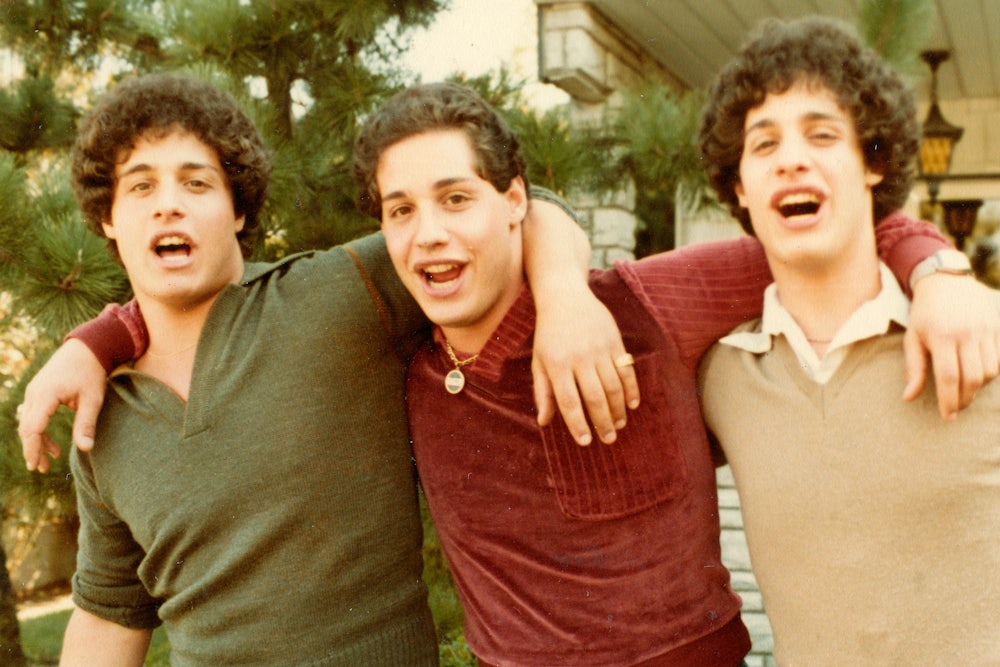The whole business of coming across one’s long-lost identical twin has changed a great deal. It used to be a case of walking past somebody who looked just like you, or being mistaken for one another. Now the internet is studded with headlines like “Separated at Birth, Reunited on Facebook” and “I Found My Identical Twin on YouTube.” Our images are everywhere online. They spread and replicate, increasing our recognizability by an incalculable factor.
The retro model is the narrative engine of the new documentary Three Identical Strangers. In 1980, Robert Shafran arrived for his first day at Sullivan County Community College in upstate New York. He was surprised when people seemed to recognize him, welcoming him with hugs and backslaps, calling him Eddy. Eventually a kid explained that his buddy Eddy used to go to Sullivan County but had not returned this year. There’s no way that Robert and Eddy weren’t twins, he said. Quivering with excitement, the two boys crammed themselves into a phone booth and called Edward Galland. The story of their reunion made it into The New York Post—which is how a photograph of the identical twins made it before the eyes of David Kellman, who turned out to be their triplet.
Three Identical Strangers tells the story of these three brothers, who were all adopted into Jewish families across New York state. Once the boys were reunited at age 19, they became a huge news story. The documentary is packed with footage of Eddy, David, and Robert on television. They were attractive young men who shared a very distinctive physicality. They all had huge, paw-like hands; wide grins; broad shoulders; curly hair; and were filled with the indomitable life force that is peculiar to 19-year-old lads. They loved each other instantly.
What made this story so visually compelling, then and now, is the fact that there are three of them. Long-lost identical twins are remarkable. But long-lost identical triplets are virtually unheard of. Their uncanny shared traits—they all liked older women, smoked Marlboros, wrestled in high school—were 33 percent more mindblowing than any story seen before. The probability of their meeting was 33 percent less likely. When the young Eddy, Robert, and David interact on screen it is not like watching a person looking into a mirror. Instead, it is a triad of voices and faces. They were also treated like show ponies by the media, and at the start of Three Identical Strangers we are invited to perceive them that way—as a lovely, happy marvel.
But then the boys’ adoptive parents arranged a meeting at the outfit that facilitated all three adoptions, the Louise Wise Agency. They were angry. Why did you split up these children? they asked. Why didn’t the agency tell the parents that there were other siblings out there? The agency told the six parents that it was simply policy, designed to maximize the babies’ chance of finding a home. The parents were cross but left. One dad, however, left his umbrella behind. When he went back to fetch it, he came across the agency bosses popping a bottle of champagne.
What follows is extraordinary. On the surface it’s a story about three happy young men who did not remain happy, and the surprising facts behind their separation and reunion. But at its deepest level, Three Identical Strangers is about the changes in the way people have seen the rights of vulnerable people, like children, in post-war America. It is a change in ethics, with the movie describing a schism that divides the adults of the 1950s and ’60s from those in the present day.
That revelation is a remarkable payoff, the product of a very clever narrative structure. First, the audience is overjoyed. Then we’re suspicious. Then we see the first big twist, and start following the clues. The mystery, which I won’t spoil, is animated by the old nature-versus-nurture question. But then there’s a second mystery, concealed by a few red herrings in the first two sections of the film. Our jaws fall open all over again, and we end the film thinking, on a narrative and a philosophical level, holy shit.
The narrative structure of Three Identical Strangers is notable, because our journey toward understanding is so controlled, to the point that it feels manipulative. A lot is kept from the viewer, then parceled out in discrete chunks. The effect is of one of those long New Yorker-style pieces that blend storytelling with feats of reporting—the elaborate set-up that is a feint, to be dispelled in an act of revelation.
Are human lives ethically available as fodder for highly constructed artworks? The taste that this movie will leave in your mouth will depend on whether you can forget about storytelling ethics in order to focus on the ethical outrage at the center of the story. Either way, the vast majority of viewers will learn about a chapter in American history that they previously knew nothing of.
